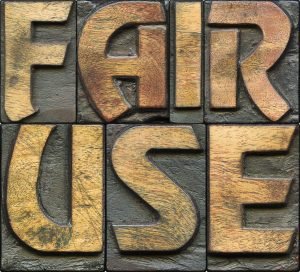The fair use doctrine as applied in the context of copyright infringement cases has resulted in countless furrowed brows and consternation. Trial courts have applied the doctrine in amorphous and miasmic ways that have left litigants flummoxed, and the resultant confusion has manifested in unnecessary legal costs and countless legal seminar panels. But a recent opinion out of the Second Circuit has brought exhilarating rays of sunshine to where there was previously not much but shadow.
In theory, fair use is simple and allows one to make use of a copyrighted work without the artist’s consent. Set forth in 17 U.S.C. § 107 are four express factors that a court must apply when deciding whether a use without consent was fair: (1) the purpose and character of the use, including whether such use is of a commercial nature or is for nonprofit educational purposes; (2) the nature of the copyrighted work; (3) the amount and substantiality of the portion used in relation to the copyrighted work as a whole; and (4) the effect of the use upon the potential market for or value of the copyrighted work.
But this straightforward framework has been corrupted and waylaid by court-driven expansion, add-ons, and filigree. Most troublingly, particularly in the Second Circuit, has been the elevation of, and overreliance on, a mysterious “transformative” factor, which does not exist in the statutory text. And which seems to run contrary to the examples of fair use in the statute’s prefatory language, which identifies “criticism, comment, news reporting, teaching (including multiple copies for classroom use), scholarship, or research” as paradigmatic fair uses.
Nobody is quite sure what it means for a work to be “transformative,” and attempts to get there veer into the metaphysical, such as when the Second Circuit wrote that a use may be fair when the underlying work is “transformed in the creation of new information, new aesthetics, new insights and understanding.” This explanation, while groovy, could apply to literally any derivative work, and derivative works cannot be created without the consent of the author. So, we are left at a loss as to when a work is “transformative” and why that should matter.
It is thus hard to blame the trial courts for the consistent waywardness that attends fair use decisions, given that they take direction from the appellate courts and, particularly in the Second Circuit, that direction has been soupy if not disastrous. At least it was, before the recent decision in The Andy Warhol Foundation for The Visual Arts, Inc. v. Lynn Goldsmith. There, the Second Circuit met the aching need for clarity that has existed since the circuit’s bizarre Cariou v. Prince decision, which has been widely criticized by courts and commentators alike (see links above).
But, that was another Prince on another day. Here, Lynn Goldsmith, a prolific and masterful photographer, created a stunning black-and-white photograph depicting a young Prince Rogers Nelson, later known as the Artist, and as a logo, and as just Prince. She, via her company, entered into a license with Vanity Fair (for younger readers, Vanity Fair was at one time a thriving magazine that sat at the very head of the cool kids table) that allowed for her Prince photograph to be used as a “visual reference” for the creation of a derivative work that would be published in Vanity Fair.
Vanity Fair then engaged Andy Warhol to muck about a bit with the Goldsmith photograph. He added color and effaced some of the definition but did not add much of substance to the underlying work. The resulting derivative was published in Vanity Fair in 1984, inclusive of a “source photograph” credit to Goldsmith.
Thereafter, despite this credit and knowledge of the reliance on Goldsmith’s photograph, Warhol sold prints of the Vanity Fair work as well as 15 other items based on Goldsmith’s photograph without advising Goldsmith, and certainly without sharing with her the proceeds.
And the copying was obvious. As the court slyly notes, the Warhol Foundation’s counsel, in an obdurate bit of lawyering “did not concede below that the Goldsmith Photograph was the source image for the Prince Series, arguing instead that “somehow, Warhol created” it. But, the court is not convinced by the “somehow” defense and further notes that the same counsel elsewhere conceded that Goldsmith’s work was the “source image” for the Warhol derivative. Also in the record was a Warhol expert’s testimony as to Warhol’s creative process, which apparently included a whole lot of tracing and even incorporated that old grade-school art exercise of “project[ing] an image onto paper” for such purposes. Warhol’s copying of Goldsmith’s work to create the derivative did not appear to be in genuine dispute.
When Warhol passed, the Andy Warhol Foundation (AWF) obtained his copyrights in the Goldsmith/Warhol work and continued to monetize the derivatives, all the way until 2016 when AWF made a deal with the very same Vanity Fair that first published the work back in 1984. This time, though, Goldsmith was excluded from the deal and the work was credited solely to Warhol.
Something momentous must have occurred between 1984 and 2016. In 1984, Vanity Fair sensibly contacted Goldsmith and negotiated a license to use her work with proper attribution. In 2016, Goldsmith’s work, the very same work, was simply exploited without consent. That something momentous is almost certainly the rise of the fair use defense. In its wake, there is no reason to pay the artist when you can simply exploit her work and later invoke fair use in court when challenged.
Which is exactly what was argued to, and credited by, the district court, which entered judgment against Goldsmith on the basis of fair use. The district court concluded that the work at issue was “transformative” because, and stay with me, this gets a bit abstruse, Goldsmith’s work depicted Prince as “not a comfortable person” and a “vulnerable human being,” while Warhol’s derivative depicted Prince as an “iconic, larger-than-life figure[.]” After invoking the magic-word “transformative,” the court seemed to give short shrift to the remaining factors, noting that the creative nature of Goldsmith’s work was “of limited importance” due to the transformation.
Finally, despite the fact that Goldsmith had literally entered into a license for the use of her work as part of the original Warhol derivative published in Vanity Fair, the court concluded that not obtaining a similar license to exploit the same and other derivatives in commerce, including a later piece in the same magazine, would not affect the market for such licenses.
The Second Circuit reversed and with vigor. But, again, it is hard to fault the district court, which was constrained in that it had to follow the very bad Cariou precedent and the hazy “transformative” analysis enthusiastically espoused therein.
This circuit here not only correctly applies the statutory fair use factors, but cabins, and even walks back to a great degree, the elusive and far-ranging Cariou analysis, noting that that case was the “high-water mark of our court’s recognition of transformative works.”
While it is hard to detect tone in a written opinion, when the opinion notes that Cariou’s directive is that we evaluate whether a work is transformative by examining how it may “reasonably be perceived” one hears a faint echo of a raised eyebrow. Of course, how a work may “reasonably be perceived” is just word salad for “looking” at a work, and the directive thus lacks utility.
In rejecting the district court’s finding that the Warhol derivative was a “transformative” fair use the circuit cautions against the “judge as art critic” and finds that “transformative cannot turn merely on the stated or perceived intent of the artist or the meaning or impression that a critic –- or for that matter, a judge –- draws from the work. Were it otherwise, the law may well “recogniz[e] any alteration as transformative.” This is precisely the reason why the “transformative” analysis was always such a morass — the definition depended on who was doing the defining.
The circuit also shunts aside some of the more mystical elements of the Cariou analysis and finds that “there can be no meaningful dispute that the overarching purpose and function of the two works at issue here is identical, not merely in the broad sense that they are created as works of visual art, but also in the narrow but essential sense that they are portraits of the same person.”
The panel adds, with a bit of a burn, that Warhol’s derivative is “closer to presenting the same work in a different form, that form being a high-contrast screenprint, than they are to being works that make a transformative use of the original.” This leads to the adroit and commonsense point that when you are looking at two pieces of visual art — here, a photograph and a stylized tracing (or screenprint) of that photograph — the question of whether the latter is “transformative” is not much help given that they have the same purpose. As a result, the district court’s conclusion that Warhol’s derivative was transformative was wholly rejected as being “grounded in a subjective evaluation of the underlying artistic message of the works rather than an objective assessment of their purpose and character.”
The circuit also, importantly, notes that derivative works like the one at issue intrude on an artist’s right to create derivatives and license others to do so. And it confirms that while previous Second Circuit panels were wasting so much time on “transformation” they were also failing to acknowledge the factor that should carry the most weight, that which looks at the “market harm” that would result if the copying at issue got a free pass. In this regard, after correctly concluding that the infringer bears the burden of proof on each factor, the court rejected the notion that Warhol and AWF “are entitled to monetize [Goldsmith’s work] without paying Goldsmith the ‘customary price’ for the rights to her work” and found that exploitation like that at issue in the case, if unchecked, would visit serious harm on both Goldsmith’s ability to license her work and the market as a whole.
The Second Circuit concludes not only that all of the stated fair use factors favor Goldsmith, but also that the Warhol derivative is substantially similar to her work as a matter of law, which will essentially establish liability for infringement when the case returns to the trial court.
This decision, even with its strength, pellucidity, and lack of equivocation, will not deter infringers and copyists from continuing to claim that their knock-off or verbatim reproduction is a “fair use,” but it will allow courts to more easily review and reject these attempts and, in due time, return the fair use doctrine to where Congress intended: the facilitation of matters of criticism, comment, news reporting, teaching, scholarship, and research.
(N.B., the author has represented Lynn Goldsmith in other matters but was not involved in the Warhol case.)
 Scott Alan Burroughs, Esq. practices with Doniger / Burroughs, an art law firm based in Venice, California. He represents artists and content creators of all stripes and writes and speaks regularly on copyright issues. He can be reached at scott@copyrightLA.com, and you can follow his law firm on Instagram: @veniceartlaw.
Scott Alan Burroughs, Esq. practices with Doniger / Burroughs, an art law firm based in Venice, California. He represents artists and content creators of all stripes and writes and speaks regularly on copyright issues. He can be reached at scott@copyrightLA.com, and you can follow his law firm on Instagram: @veniceartlaw.

